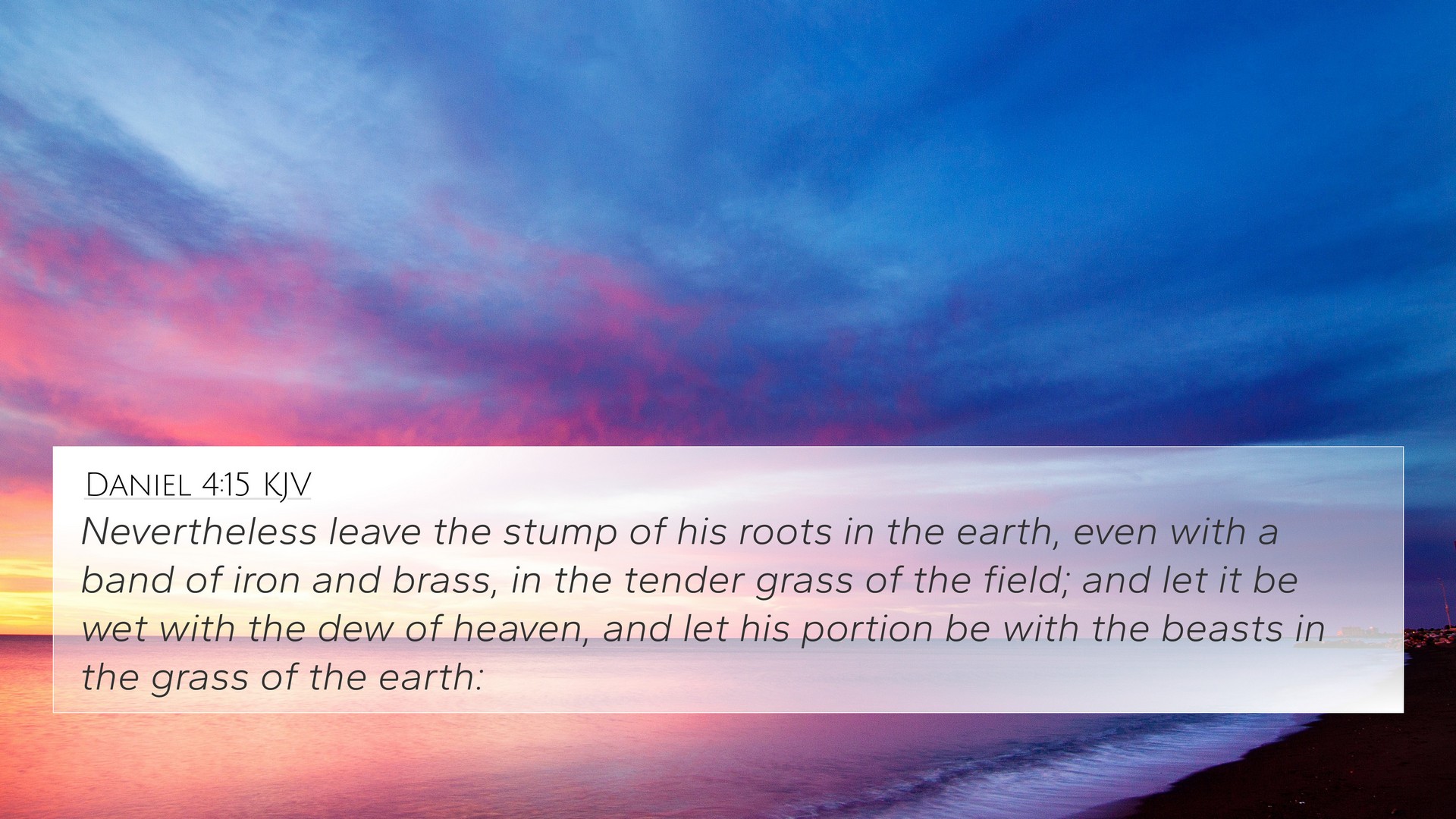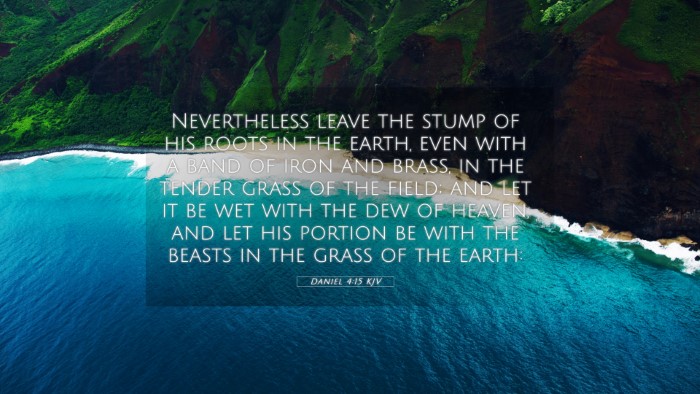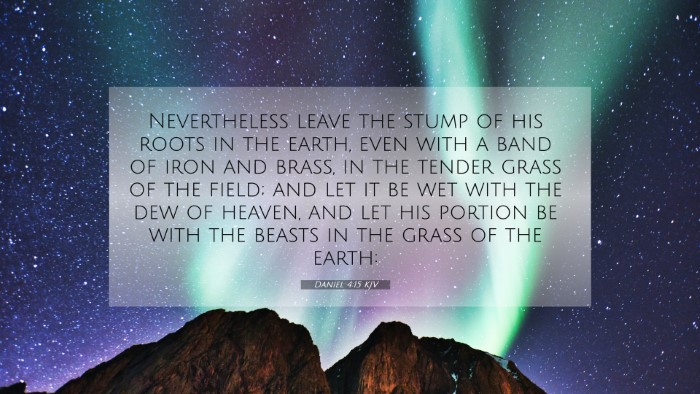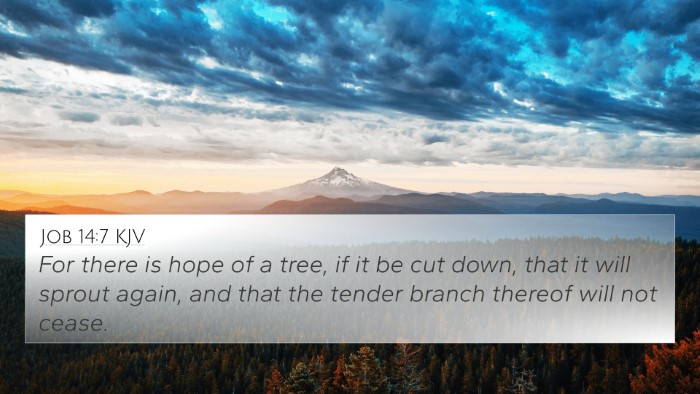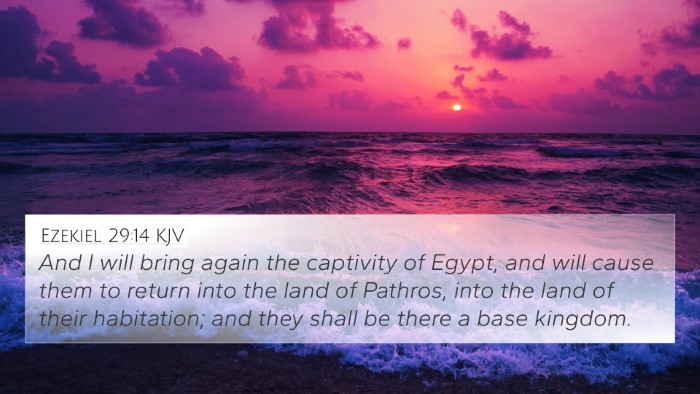Understanding Daniel 4:15
Daniel 4:15 states: "Nevertheless leave the stump of his roots in the earth, even with a band of iron and brass, in the tender grass of the field; and let it be wet with the dew of heaven, and let his portion be with the beasts in the grass of the earth:" This verse is part of a dream experienced by King Nebuchadnezzar, which is both a warning and prophecy about his future.
Summary of Key Insights
In order to understand the depth of this verse, we can draw from various public domain commentaries:
- Matthew Henry: Henry emphasizes the mercy shown towards Nebuchadnezzar through the imagery of the stump, symbolizing that while judgment is coming, there is yet hope for restoration. The stump indicates potential rebirth, as roots remain that could lead to renewal.
- Albert Barnes: Barnes notes the significance of the iron and brass band around the stump, interpreting it as a means of protection and preservation for a moment of future restoration, highlighting God’s sovereign control over the kingdoms of men.
- Adam Clarke: Clarke elaborates on the imagery of the dew and the grass, suggesting that this reflects the nurturing aspect of God’s care, even for those who stray from righteousness. It signifies a method of divine provision and care amidst impending judgment.
Thematic Connections
Daniel 4:15 connects to broader themes in scripture, illustrating the tension between divine judgment and mercy. It invites deeper reflection on God's involvement in human affairs and the potential for redemption.
Cross-References to Consider
- Isaiah 2:12: Highlights the futility of human pride and the impending judgment of the Lord.
- Jeremiah 51:34: Discusses the destruction of prideful kingdoms, connecting to Nebuchadnezzar's story.
- Ezekiel 31:3: Compares nations to trees, drawing a parallel to the vision of Nebuchadnezzar.
- Matthew 3:10: References the ax laid to the root of the trees, similar to the theme of judgment in Daniel.
- John 15:2: Jesus’ discussion on pruning trees to facilitate growth relates to the concept of leaving the roots.
- Revelation 22:2: Provides imagery of healing and restoration, akin to the potential for Nebuchadnezzar’s eventual renewal.
- 1 Peter 5:5: Encouragement to be humble, reflecting the characteristics that God desires despite judgment.'
Analysis of Biblical Themes
Through cross-referencing these verses, we notice a recurring theme of judgment paired with hope. The scripture offers profound insights into God's nature:
- Judgment and Restoration: The band around the stump implies that while judgment is certain, the possibility for restoration is always present, reinforcing a central Biblical theme of God's mercy.
- The Sovereignty of God: The imagery in this verse emphasizes God’s control over the destiny of nations and individuals alike, reminding us of the importance of humility.
- Nature of Divine Care: The wetness of the dew highlights that even in judgment, God continues to provide for His creations, showcasing His nurturing characteristic.
Resources for Further Study
For those interested in exploring deeper connections and cross-referencing other Biblical texts, several tools can aid in the process:
- Bible Concordance: A helpful resource for locating specific verses and their cross-references.
- Bible Cross-Reference Guide: A companion to enhance understanding of connections between scriptures.
- Cross-Reference Bible Study: Techniques that facilitate the study of scriptures in a coherent manner.
- Inter-Biblical Dialogue: Engaging with themes across both the Old and New Testaments to deepen understanding.
Conclusion
Daniel 4:15 offers a rich tapestry of meaning that intertwines judgment with a promise of hope. The commentaries provide diverse insights that enlighten readers on God's character as just, yet merciful. By cross-referencing with other scriptures, the full weight of this verse's significance can be appreciated, enriching one's understanding of the Biblical narrative and divine engagement with humanity.
